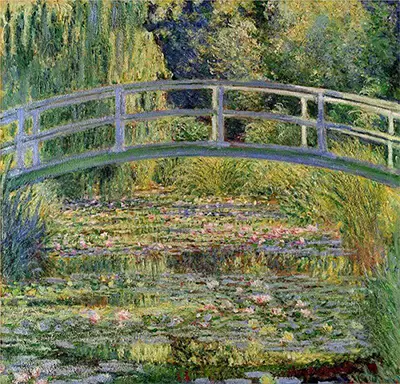The water lily paintings of Claude Monet are amongst the most recognisable image in all art history, but many are unaware of the back story behind his work within this Giverny garden. The piece captured here, for example, is now owned by the National Gallery in London, UK but is just one of several hundred paintings produced by the artist from his purpose built garden. Indeed there are countless variations just of this scene alone, where his Japanese bridge is captured at the back of the painting, with a plethora of water lilies dotted around the water lily pond below. Each iteration is very similar to the last, and indeed the next in this sequence of experimentation but those familiar with his career will take the time to differentiate them. Typically, the variations would be delivered by nature, by painting at a different time of the day or year. Monet will then discover alternative lighting effects as well as flowers at different stages of their life cycles.
The bridge itself appears almost like a rainbow, where the start and end point are hidden, giving it more of a natural look which helps it to blend in with the rest of the painting. Monet himself had purchased land adjoined to his home in Giverny in order to expand the flower garden that he had already set up. He wanted to create a new water-based addition that would be home to some stunning water lilies and the bridge would help him to get around this new piece of land, whilst also adding aesthetic beauty to some angles found here. He was known to have studied Japanese art with a great passion and the connection cannot be discounted, for that genre also frequently used bridges such as these within their landscape scenes. The use of water also was important because of his interest in studying light within art, and the reflections could offer more variables to his experimental work.
Within this series of paintings which depict his japanese bridge over the lily pond, there is no sky at all. The overhanging trees have advanced so much by 1899 that they completely block out the view of it from behind, but clearly light is still coming in from elsewhere. We see elements of the bridge that are lighter than others, for example, and in this case there is some variation in tone used for the hand rails. Besides the thick trees at the back, we also find a number of bushes which line the pond, ensuring a smooth transition between land and water. They too are well developed and overhang, with Monet seeking to disguise the manmade nature of this landscaped scene, and was trying to avoid cutting back and tidying too much once it was all in full flow. In the foreground is a huge number of water lilies which cover more than half of the water on which they sit. The look created by this is stunning, gifting the artist the opportunity to flood our eyes with tones of pink, white, green and purple.

 in Detail Claude Monet.jpg)

